

AI Repositories and Resource Lists. Artificial Intuition. Cooperation = Evolution. Role of Cooperation in the Evolution of the Brain The average human brain weighs about 2.8 pounds, has 100 billion neurons, and uses up 20% of the oxygen we breathe.
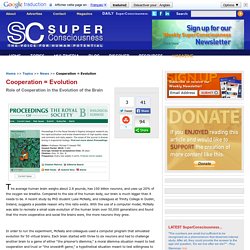
Compared to the size of the human body, our brain is much bigger than it needs to be. A recent study by PhD student Luke McNally, and colleagues at Trinity College in Dublin, Ireland, suggests a possible reason why this ratio exists. Can AI save us from AI? Stanford to host 100-year study on artificial intelligence. Stanford University has invited leading thinkers from several institutions to begin a 100-year effort to study and anticipate how the effects of artificial intelligence on every aspect of how people work, live, and play.

This effort, called the One Hundred Year Study on Artificial Intelligence (AI100) is the brainchild of computer scientist and Stanford alumnus Eric Horvitz. As former president of the Association for the Advancement of Artificial Intelligence, he convened a conference in 2009 at which top researchers considered advances in AI and its influences on people and society. Is Stephen Hawking Right? Could AI Lead To The End Of Humankind? The famous theoretical physicist, Stephen Hawking, has revived the debate on whether our search for improved artificial intelligence will one day lead to thinking machines that will take over from us.
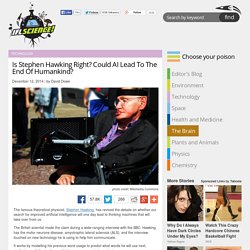
The British scientist made the claim during a wide-ranging interview with the BBC. Hawking has the motor neurone disease, amyotrophic lateral sclerosis (ALS), and the interview touched on new technology he is using to help him communicate. It works by modelling his previous word usage to predict what words he will use next, similar to predictive texting available on many smart phone devices. Stephen Hawking warns artificial intelligence could end mankind. Media playback is unsupported on your device.
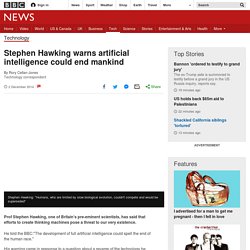
How the Cleverbot Computer Chats Like a Human. Last week, an artificial intelligence computer named Cleverbot stunned the world with a stellar performance on the Turing Test — an IQ test of sorts for "chatbots," or conversational robots.
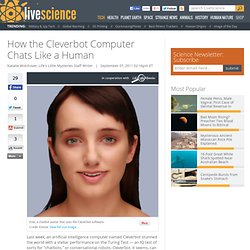
Cleverbot, it seems, can carry on a conversation as well as any human can. In the Turing Test — conceived by British computer scientist Alan Turing in the 1950s — chatbots engage in typed conversations with humans, and try to fool them into thinking they're humans, too. (As a control, some users unknowingly chat with humans pretending to be chatbots.) At a recent Turing competition, Cleverbot fooled 59 percent of its human interlocutors into thinking it was itself a human.
Analysts have argued that, because the chatbot's success rate was better than chance, the computer passed. One Per Cent: Bot with boyish personality wins biggest Turing test. Celeste Biever, deputy news editor Eugene Goostman, a chatbot with the personality of a 13-year-old boy, won the biggest Turing test ever staged, on 23 June, the 100th anniversary of the birth of Alan Turing.

Held at Bletchley Park near Milton Keynes, UK, where Turing cracked the Nazi Enigma code during the second world war, the test involved over 150 separate conversations, 30 judges (including myself), 25 hidden humans and five elite, chattering software programs. By contrast, the most famous Turing test - the annual Loebner prize, also held at Bletchley Park this year to honour Turing - typically involves just four human judges and four machines. Humanoid Robot Learns Language Like a Baby. With the help of human instructors, a robot has learned to talk like a human infant, learning the names of simple shapes and colors.
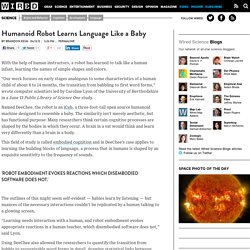
“Our work focuses on early stages analogous to some characteristics of a human child of about 6 to 14 months, the transition from babbling to first word forms,” wrote computer scientists led by Caroline Lyon of the University of Hertfordshire in a June 13 Public Library of Science One study. Named DeeChee, the robot is an iCub, a three-foot-tall open source humanoid machine designed to resemble a baby. The similarity isn’t merely aesthetic, but has functional purpose: Many researchers think certain cognitive processes are shaped by the bodies in which they occur.
The Little Thoughts of Thinking Machines. Next: About this document John McCarthy Computer Science Department Stanford University Stanford, CA 94305 jmc@cs.stanford.edu When we interact with computers and other machines, we often use language ordinarily used for talking about people.
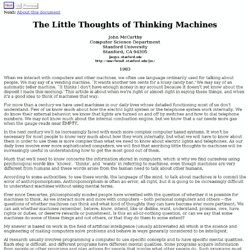
Using large-scale brain simulations for machine learning and A.I. You probably use machine learning technology dozens of times a day without knowing it—it’s a way of training computers on real-world data, and it enables high-quality speech recognition, practical computer vision, email spam blocking and even self-driving cars.

But it’s far from perfect—you’ve probably chuckled at poorly transcribed text, a bad translation or a misidentified image. We believe machine learning could be far more accurate, and that smarter computers could make everyday tasks much easier. So our research team has been working on some new approaches to large-scale machine learning. Today’s machine learning technology takes significant work to adapt to new uses. For example, say we’re trying to build a system that can distinguish between pictures of cars and motorcycles.
Fortunately, recent research on self-taught learning (PDF) and deep learning suggests we might be able to rely instead on unlabeled data—such as random images fetched off the web or out of YouTube videos. Google scientists find evidence of machine learning. Google scientists working in the company's secretive X Labs have made great strides in using computers to simulate the human brain.
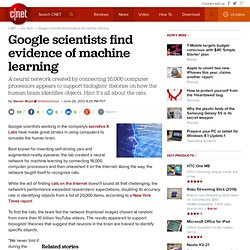
Best known for inventing self-driving cars and augmented-reality eyewear, the lab created a neural network for machine learning by connecting 16,000 computer processors and then unleashed it on the Internet. Along the way, the network taught itself to recognize cats. Virtual robot links body to numbers just like humans - tech - 11 November 2011.
Video: See a virtual robot mimic a human baby A virtual robot has acquired a cognitive wrinkle common in people – further evidence that computers need bodies if they're ever going to think like us Read more: "Squishybots: Soft, bendy and smarter than ever ONE of the many curious habits of the human brain is that we tend to associate small numbers with the left side of our body and large numbers with our right. Now a virtual robot embedded in a synthetic world has acquired the quirk. This is helping untangle the puzzle of how even highly abstract concepts such as numbers might be rooted in our physical interactions with the world. Developing artificial intelligence systems that can interpret images. Like many kids, Antonio Torralba began playing around with computers when he was 13 years old.
Unlike many of his friends, though, he was not playing video games, but writing his own artificial intelligence (AI) programs. Growing up on the island of Majorca, off the coast of Spain, Torralba spent his teenage years designing simple algorithms to recognize handwritten numbers, or to spot the verb and noun in a sentence. But he was perhaps most proud of a program that could show people how the night sky would look from a particular direction. “Or you could move to another planet, and it would tell you how the stars would look from there,” he says. Today, Torralba is a tenured associate professor of electrical engineering and computer science at MIT, and an affiliate of the Computer Science and Artificial Intelligence Laboratory (CSAIL), where he develops AI systems that can interpret images to understand what scenes and objects they contain. A.I.